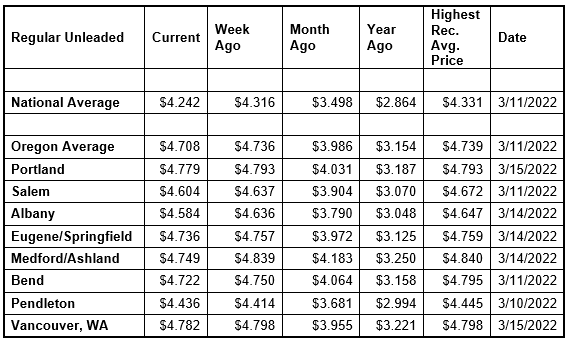
After surging to record highs earlier this month, gas prices are declining in 44 states, including Oregon. The big driver is lower crude oil prices, which skyrocketed shortly after Russia invaded Ukraine. For the week, the national average for regular loses seven cents to $4.24. The Oregon average dips three cents to $4.71.

The national and Oregon averages are both a bit lower than their record highs set earlier in March. The national average peaked at $4.331 on March 11 while the Oregon average peaked at $4.739 on March 11. These prices eclipse the old record highs set in 2008 when the national average peaked at $4.11 on July 17, and the Oregon average peaked at $4.29 on July 3.
“Lower crude oil prices and a slight reduction in demand are helping to put the brakes on rising pump prices. But the tight global crude oil market remains, so it’s impossible to say whether gas prices will rise again or if they have peaked. If oil prices climb again, pump prices will follow suit,” says Marie Dodds, public affairs director for AAA Oregon/Idaho.
On average, about 53% of what we pay for in a gallon of gasoline is for the price of crude oil,12% is refining, 21% distribution and marketing, and 15% are taxes, according to the U.S. Energy Information Administration.
About 3% of oil, and a total of 8% of oil and refined products used in the U.S. last year came from Russia, while about 25% of Europe’s oil is imported from Russia. The U.S. is the largest oil producer in the world. Other top producers are Saudi Arabia and Russia.
U.S. gasoline demand dipped slightly from 8.96 million b/d to 8.94 million b/d, perhaps because of the near-record-high prices. Total domestic gasoline stocks also decreased by 3.6 million bbl to 241 million bbl last week, according to the U.S. Energy Information Administration (EIA). The small decline in gas demand is helping to put downward pressure on pump prices, but the major factor is decreasing oil prices.
Quick stats
Oregon is one of 44 states and the District of Columbia with lower prices now than a week ago. Maryland (-47 cents) has the largest weekly decline. Nevada (+18 cents) has the largest week-over-week increase. The average is flat in Montana.
California ($5.87) is the most expensive state in the nation and is one of three states with an average above $5 a gallon. There are 34 states and the District of Columbia with an average at or above $4 a gallon.
The cheapest gas in the nation is in Kansas ($3.76) and Missouri ($3.77). This week no states have averages below $3 a gallon, same as a week ago. For the 63rd week in a row, no state has an average below $2 a gallon.
All 50 states and the District of Columbia have higher prices now than a month ago. The national average is 74 cents more and the Oregon average is 72 cents more than a month ago. This is the 17th– largest monthly increase in the nation. Nevada (+$1.18) has the largest month-over-month increase. Maryland (+20 cents) has the smallest.
All 50 states and the District of Columbia have higher prices now than a year ago, and 49 states and D.C. have a current average that’s a dollar or more higher than a year ago. The national average is $1.38 more and the Oregon average is $1.55 more than a year ago. This is the fourth-largest yearly increase in the nation. California (+$1.98) has the biggest yearly increase. Maryland (+94 cents) has the smallest year-over-year increase.
West Coast
The West Coast region continues to have the most expensive pump prices in the nation with all seven states in the top 10. This is typical for the West Coast as this region tends to consistently have fairly tight supplies, consuming about as much gasoline as is produced.
| Rank | Region | Price on 3/22/22 | ||
| 1 | California | $5.87 | ||
| 2 | Nevada | $5.14 | ||
| 3 | Hawaii | $5.09 | ||
| 4 | Washington | $4.73 | ||
| 5 | Oregon | $4.71 | ||
| 6 | Alaska | $4.70 | ||
| 7 | Arizona | $4.62 | ||
| 8 | Illinois | $4.50 | ||
| 9 | District of Columbia | $4.37 | ||
| 10 | New York | $4.36 |
California is the most expensive state for the 61st week in a row with Nevada, Hawaii, Washington, Oregon, Alaska, and Arizona rounding out the top seven. Oregon climbs to fifth after one week at sixth.
Nevada (+18 cents) has the largest weekly increase in the region while Alaska (-4 cents) has the largest week-over-week decline in the region.
The refinery utilization rate on the West Coast increased from 81.2% to 85.0% for the week ending March 11. The rate has ranged between about 76% and 88% in the last year.
According to EIA’s latest weekly report, total gas stocks in the region fell from 30.12 million bbl. to 28.65 million bbl.















